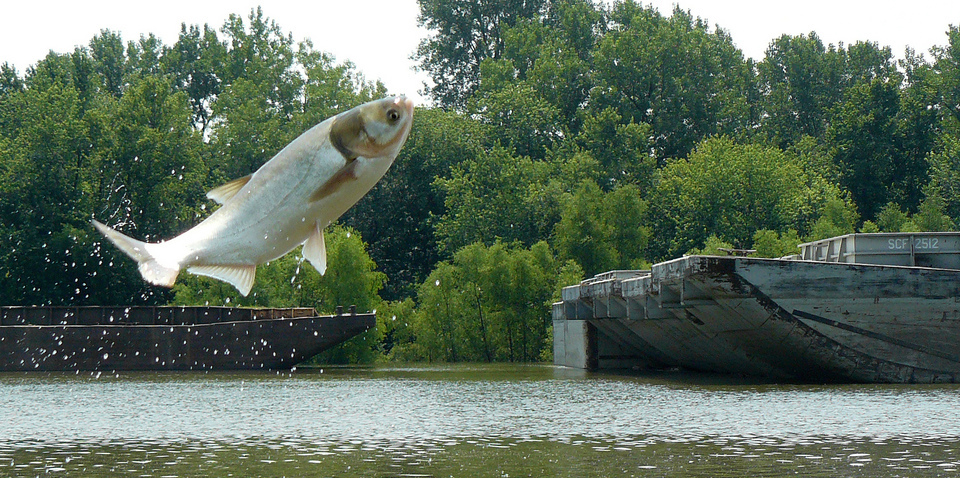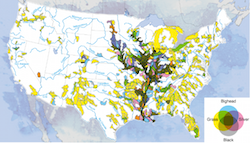The next line of defence against keeping invasive Asian carp out of the Great Lakes will come at an 81-year-old lock and dam in Joliet, Illinois, 65 kilometres south of Chicago on the shores of Lake Michigan.
The next line of defence against keeping invasive Asian carp out of the Great Lakes will come at an 81-year-old lock and dam in Joliet, Illinois, 65 kilometres south of Chicago on the shores of Lake Michigan.
The Brandon Road dam, listed on the National Register of Historic Places in March 2004, is being investigated by the U.S. Army Corps of Engineers as a suitable location to test run new deterrents for halting Asian carp and other aquatic nuisance species. In addition to the electric barriers already in place eight kilometres upstream from the Brandon Road project, the Corps hopes to evaluate the effectiveness of gates, air cannons and boat cleanses in repelling invasives.
Asian carp, first introduced to US federal aquaculture facilities in Arkansas in 1963, have spread throughout the country via the Mississippi, Missouri and Illinois rivers and their tributaries. Their massive appetites, large growth and high reproductive rates have made them dangerous invaders for native species who have struggled to compete against them for resources.
While the Corps consults the public (Canadians are encouraged to comment, too – until January 30, 2015) and studies the Brandon Road site as the latest defensive position, a trio of Democrat and Republican Senators and Congresspersons from Michigan and New York brought forward the Guarding the Great Lakes Act last week.
The bill, introduced by Senator Debbie Stabenow (D-MI) on December 11, would order the Army Corps (an engineering branch of the Department of Defence that takes direction from Congress) to immediately begin constructing new barriers at the Brandon Road dam. If passed, it would also require the Corps to beef up existing security measures along the Chicago Area Waterway System, the vector point many fear Asian carp will use to enter the Great Lakes.
“This is an emergency, and the time has come for decisive action before it’s too late,” Stabenow said of the bipartisan effort.
In addition to spurring the Corps into action, the Stabenow bill would also direct the Great Lakes Interagency Task Force, working under the Environmental Protection Agency, to investigate water quality and flood mitigation issues in the region with local and state governments. This is in preparation of a potential separation of the Great Lakes from the Mississippi River, an $18-billion proposal from the Corps to permanently separate the basins and eliminate Chicago as a possible transfer point for Asian carp.
This provision was also put in place to please those states (namely Indiana and Illinois) worried about what impact such separation would have on flood mitigation and drinking water quality. Currently, when heavy rains fall on the Chicago area, city staff are able to override the Chicago River’s flow and push flood waters into Lake Michigan for immediate disposal. With a physical barrier in place between the lake and river, this may no longer be an option.
Congresswoman Louise Slaughter (D-NY), another sponsor of the bill, said Washington’s response to the Asian carp crisis has been consistently reactive as the federal government has been unable to get ahead of the problem. “We have paid a dear price,” Slaughter said. “We have to take this problem head on.”
Congressman Dave Camp (R-MI) was the third sponsor of senate bill S.3002, which has been referred to the Committee on Environment and Public Works.
Events in Hamburg, Illinois, earlier this Fall show that efforts to halt the water-based spread of Asian carp may not be enough to contain them.
On October 7, 2014, Randall E. Watters was arrested and charged in Calhoun County in the state’s southwest for the unlawful possession and sale of more than 1,800 pounds of bighead and silver carp, a Class 3 felony under United States law. If convicted, Watters faces two to five years imprisonment in addition to fines or restitution of up to $25,000.
Meanwhile, in Canada
With this kind of illegal transport of invasive species in mind, in early December Gail Shea, Canada’s Minister of Fisheries and Oceans, announced Ottawa would take steps to limit the importation of invasive species and their transfer between provinces.
According to the proposed regulatory changes, which are open to public comment until January 5, 2015, the existing patchwork of provincial laws are insufficient to halt the spread of aquatic invaders. The new rules would make it illegal to import or transport the 88 “significant risk” species listed, make it easier to add new species to this list and give federal and provincial wildlife and border agents greater powers to search and enforce the rules.
RELATED: Ontario’s Highly Praised Invasive Species Act Gets a Second Chance
“Since 2006, we have invested in science, prevention, early warning, rapid response and management and control,” Shea said. “We must remain vigilant in these efforts, and our proposed new regulations under the Fisheries Act will bolster our ability to fight the entry and establishment of aquatic invasive species and give those stewards of our fish and fish habitats more ammunition in that fight.”
Read more about the Asian carp problem in “Carpocalypse Now” in our Water issue, and see where each of the four species have been found in our interactive Carp-Occupied Territories map.
Andrew Reeves is the Editor-in-Chief of Alternatives Journal. Overrun, his book about Asian carp in North America, will be published in Spring 2019 by ECW Press. His work has also appeared in the Globe & Mail, Spacing and Corporate Knights. Follow him on Twitter.














